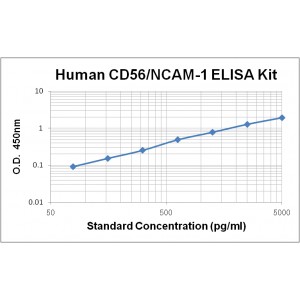More info
Assay Range | 78 - 5,000 pg/mL |
Sensitivity | 10.0 pg/mL |
Size | 96T |
Storage | Store at 2 - 8ºC. Keep reconstituted standard and detection Ab at -20 ºC |
Assay Principle | Sandwich ELISA |
Sample Volume | 100 µL final volume, dilution factor varies on samples |
Detection Method | Chromogenic |
Kit Components
1. Recombinant Human CD56 standard: 2 vials
2. One 96-well plate coated with Human CD56 Ab
3. Sample diluent buffer: 12 mL - 1
4. Detection antibody: 130 µL, dilution 1:100
5. Streptavidin-HRP: 130 µL, dilution 1:100
6. Antibody diluent buffer: 12 mL x1
7. Streptavidin-HRP diluent buffer: 12 mL x1
8. TMB developing agent: 10 mL x1
9. Stop solution: 10 mL x1
10. Washing solution (20x): 25 mL x1
Background
Neural cell adhesion molecule-1 (NCAM-1), also known as CD56, is a member of Immunoglobulin (Ig) superfamily. NCAM-1 is characterized by five C-2 type Ig-like domains and two fibronectin type III domains. Alternative splicing of NCAM-1 gene has generated at least 27 spliced NCAM-1 isoforms. The three main isoforms of NCAM-1 vary only in their cytoplasmic domain: they are designated NCAM120, NCAM-140, and NCAM180. NCAM120 is GPI-linked, while NCAM-140 and NCAM180 are type I transmembrane glycoproteins. Human NCAM-1 is 93% amino acid sequence identical to mouse counterpart. NCAM-1 specifically binds to heparan sulfate proteoglycans, the extracellular matrix protein agrin, and several chondroitin sulfate proteoglycanssuch as eurocan and phosphocan. NCAM-1 is shown to be highly sialylated. The polysialyation of NCAM-1 reduces its adhesive property and increases its neurite outgrowth promoting capability. Sialylation of NCAM-1 in the adult brain is decreased, compared with earlier developmental periods. In regions that retain a high degree of neuronal plasticity, however, the adult brain continues to express polysialylated NCAM-1, suggesting sialylation of NCAM1 is involved in regenerative processes and synaptic plasticity.


